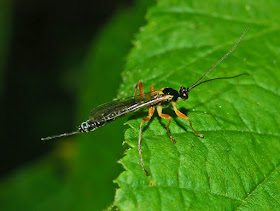This is the second post in a series of blog posts written by students from my third year Evolutionary Parasitology unit (ZOOL329/529) class of 2015. This particular post was written by Brenda Cornick and it is about an outbreak of a microsporidian parasite that causes rabbits to look like they were being animated by Shaft Studio (you can read the previous post about a parasitoid that commandeer a spider to weave a tangled web for it here).
 |
An Encephalitozoon cuniculi spore
From Figure 7 of this paper |
For those with pet rabbits, Calicivirus and Myxoma virus are generally thought to be the main dangers to bunny's health. However, there is another nasty lurking within our little furry friends that you may not be aware of - the parasite
Encephalitozoon cuniculi. The vast majority of rabbits that carry this parasite show no symptoms at all, and can live a normal healthy life. But for the unlucky few that are affected, the symptoms are particularly unpleasant, and usually fatal. There was an outbreak of
E. cuniculi in a rabbit colony at a Japanese zoo between 1999-2001 that claimed the lives of 42 rabbits. But before we look at the study surrounding this outbreak, a summary of how this parasite operates would be helpful.
Encephalitozoon cuniculi is a type of
microsporidian, a single-cell parasite equipped with a structure called a polar tube, which is curled inside the infective spore. Spores are the infectious stage, and are either inhaled or consumed by the host. When it comes into contact with a host cell, the spore discharges its polar tube and penetrates the cell membrane, allowing the parasite to enter. It is an intracellular parasite that lives inside its host's cell, and this species also attacks the host's central nervous system. The most common means of transmission is from the urine of an infected rabbit.
 |
Dat Shaft head-tilt
From Figure 1 and 2 of this paper |
In rabbits that develop disease from
E. cuniculi infection, clinical symptoms include
head tilt, loss of balance, weakness in the hind legs, depression, stunted growth, and lesions results from inflammation caused by the rupturing cells releasing spores. Rabbits showing some or all of these symptoms, can have nodules and cysts on their internal organs such as brain, heart, liver, and kidneys. This parasite has also been known to be transmitted to humans with compromised autoimmune systems, such as those suffering from AIDS, and was listed by the World Health Organisation as an emerging infectious agent.
Encephalitozoon cuniculi spores are able to survive pretty well in the external environment, but can be eradicated with the use of standard disinfecting routines.
In Japan, this nasty little parasite has also been found in squirrel monkeys and domestic dogs living in close quarters with humans. The
E. cuniculi outbreak at the Japanese facility prompted the study featured in this post, which involved clinical and pathological examinations, and biosecurity countermeasures. The alarm was first raised when two young bunnies showed signs of a central nervous system problems. Blood tests were conducted, and those bunnies were diagnosed with encephalitozoonosis. Following these cases, biosecurity measures were put in place included monitoring, isolation, and transport limitation. Any rabbits even suspected of harbouring
E. cuniculi were humanely euthanized. Despite these measures, periodic infections were still occurring, leading to the entire rabbit colony being euthanized. In total, 32 out of the 42 (76.2%) rabbits were found to be infected with
E. cuniculi.
Following this incident, the facility was closed and all the equipment, such as cages, feeders, floors were thoroughly sterilized using burners, 70% ethanol solution, and boiled water. New rabbits were introduced back into the facility two months after this procedure. and there has been no recurrence of
E. cuniculi outbreaks.
It became clear during this study that the original infection had come from eight rabbits that were introduced to the colony with no quarantine period. Due to the lack of simple biosecurity measures, the act of introducing new bunnies became a death sentence for the whole colony. For this particular facility, the rabbits were a popular interactive attraction for visitors, many of whom were infants or the elderly whose immune systems may not be as strong as others. This highlights the importance of adequate biosecurity and husbandry techniques when dealing with readily transmissible parasites that can be harboured by multiple host species, and can have such devastating effects.
Reference:
Fukui, D., Bando, G., Furuya, K., Yamaguchi, M., Nakaoka, Y., Kosuge, M., & Murata, K. (2013). Surveillance for an Outbreak of
Encephalitozoon cuniculi Infection in Rabbits Housed at a Zoo and Biosecurity Countermeasures.
Journal of Veterinary Medical Science,
75(1), 55-61.
This post was written by Brenda Cornick












